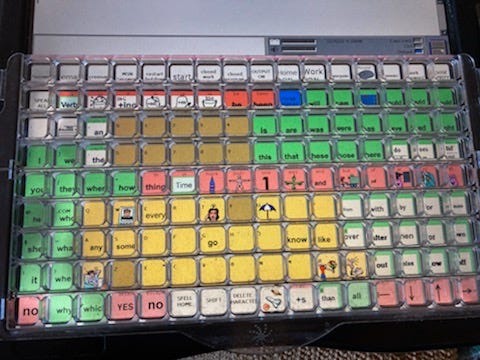ECO2: More Than a Speech Synthesizer
Written by Accessible's newest writer while using the ECO2.
I am proud to introduce Accessible’s newest writer, Jeffrey Nurick–
Jeffrey is currently an author for Accessible, a well-known self-advocate, and has been working in the intersection of policy and accessibility for over a decade. Jeffrey’s full bio can be found at the bottom of this article.
ECO2: More Than a Speech Synthesizer
I was born with Cerebral Palsy. This has presented many challenges in my life, and the biggest one is my speech impediment. I have had many other obstacles to overcome, and there was a time when I was in denial that my speech impediment was a big deal. In reality, it is the biggest, related to my disability.
In school and college, I was in denial of my speech impediment because everybody understood—or pretended to—understand me. When I took speech therapy in school every week, we worked on letters that were hard for me to pronounce. While I thought I was making progress, it was suggested that I look into a speech machine. I thought “Why? Everybody can understand me.” I made this to be true because I surrounded myself with loved ones and people who truly did.
I came to the realization that to get employed, nobody would take this amount of effort to understand me. I considered that it was time to look into that speech synthesizer after all.
The impact of a speech machine
When people think of a speech machine, they think of an automated keyboard that speaks clearly. This is a correct assumption, but there are many more things that these devices can do.
When I was living in New York, a speech therapist suggested the Pathfinder. This was the first device that I used, and I grew attached to it. The software in the Pathfinder that allowed me to program words or phrases was called Adult Quick Learning System (AQLS), created by Semantic Compaction Systems. The software has common words used in everyday speech that are expressed through letter combinations to make everything quicker. For example, each word of “What will you do?” is pre-programmed. Learning this system took years of self-study and common sense.
The following are some examples of AQLS language:
HH=hello, how are you?
NY and state =New York
NY and capital =Albany.
Like everything else, as the device aged, it was hard to get parts for the Pathfinder. AQLS was unique and most people weren’t familiar with it. And unfortunately, no new speech machine already incorporated AQLS. As a result, I faced the reality of learning how to communicate through a whole new computer language—and I had no interest in learning another program.
Finally, I met somebody who was familiar with AQLS and acknowledged how hard-headed I was. She introduced me to the ECO21, which is my current speech machine, and I have been using this for over five years. She took it upon herself to program my speech machine with AQLS; I was shocked and grateful. This was a major undertaking on her behalf and took her months to complete.
How I use the ECO2
There are two modes available on the ECO2:
Spell mode
Minspeak
As you can imagine, I type my name often. When I am in Minspeak mode, instead of typing each letter individually, I just type “jj” for Jeffrey or “jn” for Jeffrey Nurick. Sometimes I write about “Employment for People with Disabilities.” Instead of typing that out, I type “ed” and I get Employment for People with Disabilities. I also have a friend named Ed. When I write to Ed and not about Employment for People with Disabilities, I make sure I am in Spell mode. The ECO2 also has word prediction, which makes typing faster. Such pre-programmed programs are called macros.
If I am working on the computer, I can use the ECO2 as my keyboard, either by Bluetooth or hardwire.

Activities vs Notebooks
Now that I described the basics of the ECO2, it is time to get a little more complicated. I think you, the reader, can handle it.
What is an activity?
The ECO2 with AQLS has an activity row with fifteen spots to program anything I want. For example, if I were to give a PowerPoint presentation, I would write what I want to say for each slide. For those slides with larger amounts of text or that are more difficult for me to say, I could make an activity. I use every other button on purpose: to avoid pressing the wrong button. If someone in the audience has questions, activities are short, so they can wait until the ECO2 is done speaking.
The user of the device can use activities to fit their lifestyle. For example, you can make your email and passwords separate activities—these are frequent activities that I use.

What is a notebook?
Notebooks are different from activities due to the length of text you are able to program and the fact it does not pause. ECO2’s manual recommends it specifically for giving speeches.
I do not use notebooks a lot. Once you start a notebook, if for some reason you have to pause, you cannot resume from where you left off and you have to start again from the beginning of your text. For example, I used to order pizza a lot. I programmed what I wanted on a pizza and my notebook—“My name is Jeffrey Nurick. I want a large pepperoni for pick-up”. Another example is in job interviews, they often ask about my ideal job. I have described my ideal job in a notebook. These types of things you do not have to pause for. However, the quicker nature of activities is why I prefer them over notebooks.

Dictionary
The English language is weird. Some words sound alike and have two different meanings, like “hear” and “here.” For speaking, it does not matter how they are spelled, as long as they sound right. Some words have to be spelled wrong for them to sound right, rite? The ECO2 has a dictionary function. I can add words to the dictionary to make sure they are spelled phonetically.
Memory
As you can tell, you can store a lot of information on the ECO2. Every now and then, I recommend that you plug in a flash drive to back up your machine. Like all technology, the ECO2 has the potential to crash. In this situation, you can plug in the flash drive to get back everything you have saved. If you do not back everything up, you would be in trouble.

How the ECO2 has helped in my adult life
In summary, the ECO2 allows different shortcuts that enable faster typing and clearer speaking and communication for presentations or everyday conversations. This is a huge plus in the employment world, when you are expected to have the same productivity as your coworkers. The ECO2 has definitely increased my productivity and helped me be competitive in the employment world.
Jeffrey Nurick’s bio
Jeffrey Nurick is currently an author for Accessible and will be writing about assistive technology that has helped him in his productive life. Jeffrey is a well-known self-advocate who regularly presents, consults, and supports employment-related research. He is a former Ambassador for the Disability Hub, MN and was a Project Specialist at the University of Minnesota’s Institute on Community Integration for ten years. Jeffrey can often be found presenting to organizational and state leadership and bringing his message to self-advocates and family members of people with disabilities. Jeffrey was a board member of the Minnesota Association for People Supporting Employment First and is currently a board member of the Executive Council of Employment Support Professionals. He has worked at the National Organization on Disabilities, interned in the White House during the Clinton administration, and served a two-year assignment with AmeriCorps.
The Eco2 was created by PRC-Saltillo, a private company founded in 1996 and based in Wooster, Ohio. PRC focuses solely on developing and manufacturing augmentative and alternative communication devices. They have no funding rounds on record, but that has not stopped them from creating a huge amount of hardware, software, and accessories in the AAC world.
As always, image credit for Nurick’s bio photo to the wonderful Ren.




What's the abbreviation of ECO2? Can anybody answer?